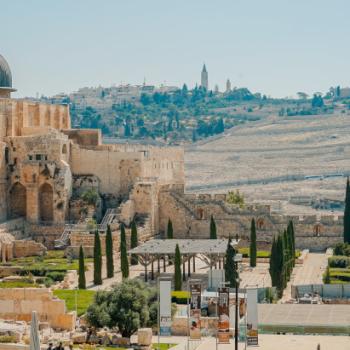
Every once in a while, I run into a theme in scripture that I’ve never noticed before. But, once I’ve seen it, I can’t un-see it. Instead, the more I read, the more I find other passages that play into that theme, until it seems so common that I can’t believe I didn’t notice it before!
Over the last several years, the idea that all of creation is God’s temple has been just such a theme. Despite living as a Christian for decades, it was an idea I had never heard mentioned. I had read passages that teach it, but hadn’t paid them any attention. Somehow, I guess I just missed it!
But then I read John Walton’s The Lost World of Genesis 1 and G.K. Beale’s The Temple and the Church’s Mission. And I started listening to some of N.T. Wright’s discussions of creation, temple, and the image of God. And I found that all three of these scholars were making the same consistent argument about creation: that heaven and earth, all the universe, are portrayed in scripture as God’s temple.
Now, this is a biblical theme that I can’t un-see. So today, I want to lay out some of the evidence for this idea. And perhaps I can help you see it too.
The Temple as the Place Where God Rests
One of the first things to notice as we approach the idea that scripture portrays creation as a temple is that the Bible says the temple is the place where God rests.
Consider, for example, Psalm 132. It’s a Psalm of Ascents, meaning a Psalm that was intended to be sung by travelers on their way to the temple. So, unsurprisingly, it deals with the temple as a theme. And it includes these lines.
‘Let us go to his dwelling place; let us worship at his footstool!’ Arise, O Lord, and go to your resting place, you and the ark of your might… ‘This is my resting place forever; here I will dwell, for I have desired it.’
I suspect most of us are used to hearing the language of God “dwelling” in his temple. But Psalm 132 uses “dwelling” and “resting” almost interchangeably to describe God’s presence abiding in the temple in Jerusalem. In other words, it pictures God resting in his temple.
And there’s an interesting overlap between this Psalm and Solomon’s dedication of the temple in 2 Chronicles 6. In that chapter, Solomon gives a long speech dedicating the temple. And he concludes by saying “And now arise, O Lord God, and go to your resting place, you and the ark of your might.” Solomon has quoted Psalm 132 (or perhaps Psalm 132 quotes Solomon), asking God to come and rest in the new temple!
And the very next verses record how the glory of the Lord comes and fills the temple!
Creation as the Place Where God Rests
So, we have evidence from scripture that God “rests” in his temple. But do we have further evidence that God rests in creation as his temple? Well, the first key to answering that question lies first in the very word “rest.” The first thing that comes to mind when we think about God “resting” is his seventh-day rest at the end of the creation account. God creates the universe and then he rests.
According to many scholars, people in the Ancient Near East would have been very familiar with the idea of gods “resting” in temples. So, they would have immediately interpreted God’s resting at the end of creation as God coming to dwell in his newly-constructed creation-temple.
But we don’t have to just trust the scholars on this. Listen to what the prophet Isaiah says in chapter 66, verses 1-2.
Thus says the Lord: “Heaven is my throne, and the earth is my footstool; what is the house [i.e., temple] that you would build for me, and what is the place of my rest? All these things my hand has made, and so all these things came to be, declares the Lord.”
Here, God seems to be saying, “What need do I have of a temple? The whole universe is my temple! I created it so that I could rest in it!” Isaiah therefore holds together the ideas of creation, temple, and God’s rest!
And, lest there be any doubt about this interpretation, Stephen makes exactly the same argument in Acts 7. He’s about to be killed for speaking against the temple, and he defends himself by saying that “the Most High does not dwell in houses made by hands.” And then he quotes Isaiah 66 as evidence!
Temple Language in the Creation Account
But it’s not just that there’s evidence elsewhere in scripture that creation is spoken of as God’s temple. Many scholars, both ancient and modern, believe that there is significant overlap in language between the creation account in Genesis 1-2, and various references to the tabernacle and temple later in scripture.
Consider, for example:
- The sun, moon, and stars are called “lights” in Genesis 1. This word “light” is never used to describe celestial bodies elsewhere in scripture, but it is used to describe the lampstand in the tabernacle (e.g., Exodus 27:20).
- Adam is instructed in Genesis 2 to “tend and keep” the garden, which could also be translated as “serve and guard.” Outside Genesis 2, these Hebrew words appear only in reference to the work of the priests in the tabernacle and temple.
- The word for God’s “walking” in the garden in Genesis 3 is the same one used to describe his dwelling in the tabernacle in Leviticus 26:11-12.
- There are dramatic parallels between God’s evaluation of his finished creation in Genesis 1-2, and Moses’ evaluation of the finished tabernacle in Exodus 39 and 40. Both passages use the terms “see,” “completed,” “finished,” “blessed,” and “sanctify” in very similar ways. In reflecting on this phenomenon, commentator Gordon Wenham writes that it “suggests that the erection of the tabernacle is being compared to God’s creation of the world.”
And this is only a sampling. There are many more interesting parallels between texts describing the tabernacle/temple and the creation account. All of them point to the possibility that scripture conceives of the universe as God’s temple.
But there’s still one more thing we need to see to fully appreciate this biblical idea.
The Image of God
One of the most well-known features of the Genesis creation account is its declaration that God made humanity in his own image. That claim has been the basis for the strong commitment to the value and dignity of human life that’s characterized the Judeo-Christian worldview. But it’s also strikingly good evidence for the idea that scripture treats creation as God’s temple.
Think about just about any temple in the ancient world (other than Israel’s). What would you find inside it? An idol. Or, in biblical terms, a “graven image.” In fact, the word used for “image” in the Genesis account is later used throughout the Old Testament to refer to idols (see, e.g., Numbers 33:52). Thus, we have evidence to believe that Adam and Eve stood as the “image of God” in the grand temple of creation, just as graven images stood in pagan temples.
And, if this hypothesis is correct, it tells us something interesting about what it means to be image bearers! The image in a temple represents the god to the worshipers, and receives their worship on behalf of the deity. So we, too, are to be God’s representatives, reflecting his love and his character into his world. Moreover, when we receive praise, we are to direct that glory back to him.
Conclusion
Thus, for all these reasons, I believe we have ample evidence to see the created universe spoken of in temple terms all throughout scripture. The Bible refers to creation as God’s temple. The Genesis 1 account contains literary features that refer to God’s creative acts using temple language. And the crowning aspect of God’s creation is humanity, made in his image, and placed into his temple to reflect his character and direct all worship to himself.
Perhaps you’ve found this case convincing. Or perhaps not. I’d love to hear about it in the comments! Please scroll down and leave some thoughts if you’d like. You can also find me on Twitter.
And stick around! There’s so much more to be said on this topic. I may do another post on it at some point. For example, we haven’t even mentioned the blending of temple and creation imagery that goes on in Ezekiel and Revelation. There’s entire chapters of scripture in those two books that lend further support to this argument!
Finally, I mentioned it in the introduction, but I want to make sure I give credit where credit is due. I’m heavily indebted to G.K. Beale, John Walton, and N.T. Wright for the ideas I’ve been describing today. If you’d like to read more about this subject, I highly recommend checking out Beale’s The Temple and the Church’s Mission. It’s a serious scholarly read, but it’s also extremely rewarding stuff!
Image Credit: Greg Rakozy / Unsplash












